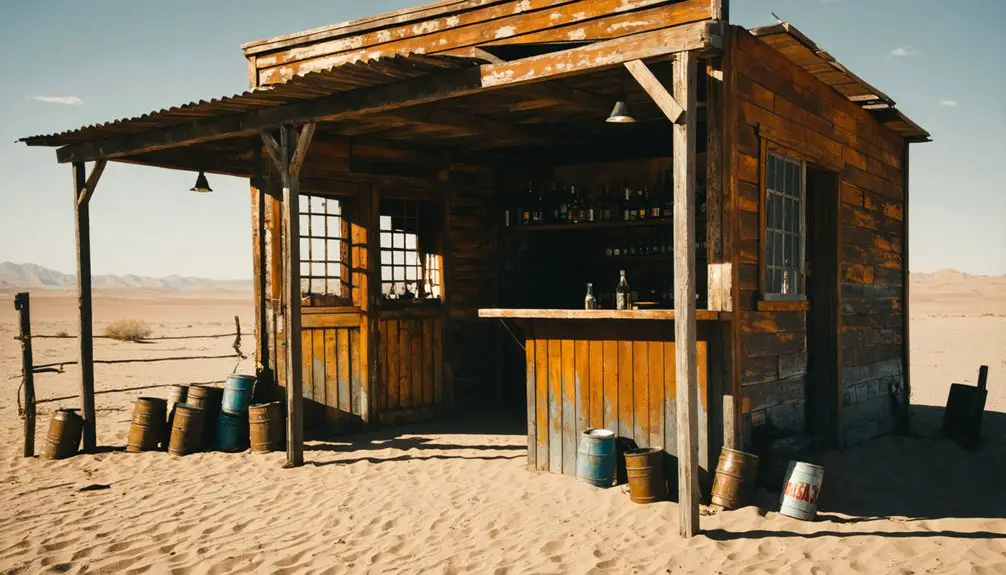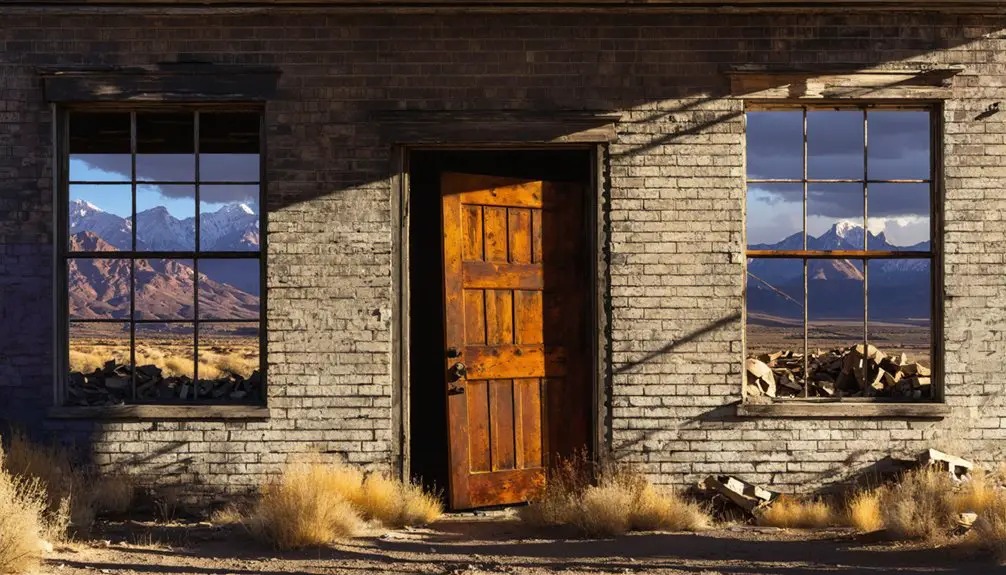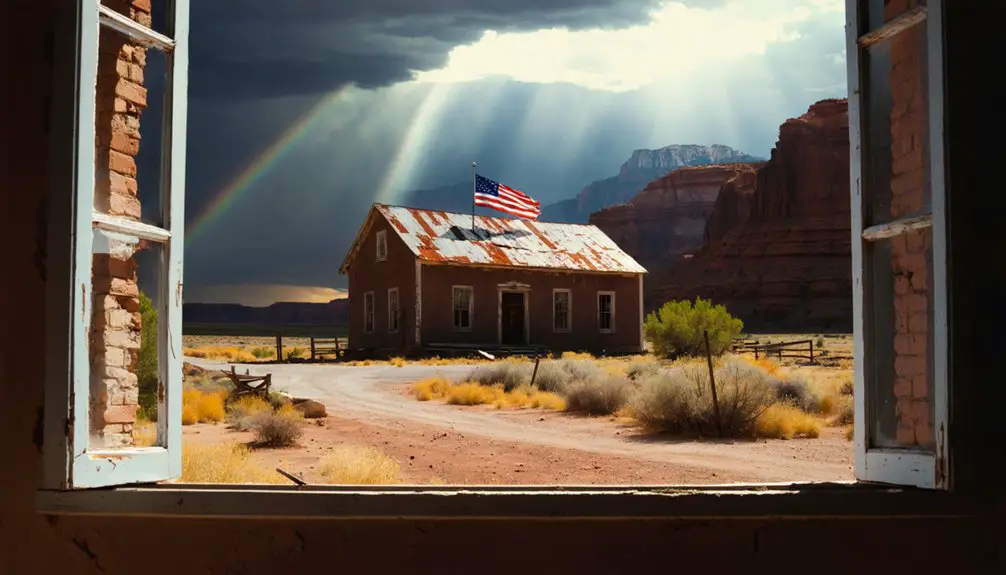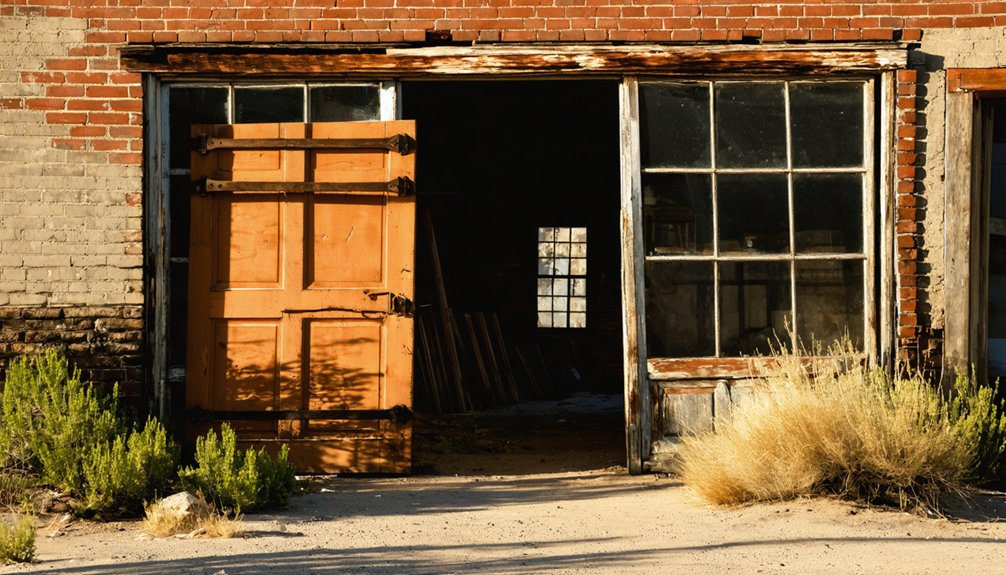You’ll discover Utah’s haunting Juab County ghost towns in the historic Tintic Mining District, where over half a billion dollars in silver and gold were extracted between 1869 and 1959. Places like Silver City, once home to 800 residents, thrived with railroads, hotels, and the bustling Tintic Smelter. Today, these abandoned settlements tell tales of boom-and-bust cycles, with eerie structures and mysterious folklore like the White Lady of Spring Canyon beckoning you to uncover their secrets.
Key Takeaways
- Silver City flourished with 800 residents by 1899, boasting railroads, hotels, and the Tintic Smelter before becoming a ghost town.
- The Mammoth Mine discovery created a boomtown of 2,800 people by 1910, now preserved as a historic ghost town site.
- The Tintic Mining District produced over half a billion dollars in precious metals before its towns were largely abandoned.
- Visitors can explore abandoned mine sites including Sunbeam, Dragon, Mammoth, and Bullion Beck in Juab County.
- The White Lady of Spring Canyon legend features mysterious green lights and reported ghost sightings near the Latuda mine entrance.
The Rise and Fall of Silver City’s Mining Empire
While Native American miners had long known of mineral deposits in Dragon Canyon, Silver City’s mining empire began in earnest when George Rust discovered these ancient diggings in 1869. The Sunbeam Mine claim soon followed, but you’d have found the early mining techniques challenging – this wasn’t easy placer mining, but demanding hard rock extraction that required substantial capital.
Despite these hurdles, Silver City flourished. By 1899, you’d have seen a bustling town of 800 people, complete with railroads, hotels, and the impressive Tintic Smelter. The area became so significant that it required a place name disambiguation to distinguish it from other Silver City locations across America.
The Salt Lake & Western Railway reached the town in 1883, bringing new opportunities for ore transport and commerce. Economic fluctuations tested the town’s resilience, particularly when rising water levels flooded mine shafts in the 1890s. The devastating fire of 1902, combined with persistent flooding issues, ultimately sealed Silver City’s fate.
Mammoth: A Tale of Gold Rush Glory
After the discovery of the Mammoth Mine on February 26, 1870, a bustling boomtown quickly emerged beneath the mine’s entrance in Utah’s Tintic Mining District.
You’d find a thriving community that grew to over 2,800 residents by 1910, despite the harsh conditions and water scarcity that forced locals to pay dearly for each gallon. The construction of a water pipeline from Jenny Lynn Spring helped sustain the growing population in the 1880s.
- The town boasted four grand hotels, a movie theatre, and a school serving nearly 500 children.
- Mining operations ran continuously for 75 years, extracting valuable silver and gold.
- Labor unrest in 1917 led to temporary shutdowns and worker strikes.
- Mammoth’s disasters, including devastating fires in 1912, 1926, and 1928, combined with legal battles over taxation, ultimately led to the town’s disincorporation in 1929.
Today, this once-mighty mining empire stands largely abandoned, though a few determined souls still call it home. The mine’s richest deposits became known as the Old Glory Hole for its exceptional gold quality.
Tintic’s $100 Million Legacy
If you’d ventured into the Tintic Mining District during its heyday, you’d have witnessed one of Utah’s most profitable mineral extraction operations, which yielded over half a billion dollars in silver and gold.
The district’s exceptional productivity placed it as Utah’s second-highest gold producer after Bingham Canyon Mine by 1959, while its uniquely high silver content made it particularly lucrative for investors and mining companies.
The region’s mining wealth peaked at $16,200,000 in 1925, marking an extraordinary year for the district’s mineral production.
First discovered in 1869 by George Rust, the district rapidly transformed from Indigenous territory into a booming mining hub.
Today, you can still explore the physical remnants of this wealthy mining era through the district’s preserved structures, including the historic Porter Rockwell Cabin and Tintic Mining Museum, which showcase the region’s remarkable economic heritage.
Mining’s Economic Peak
Between 1890 and 1926, the Tintic Mining District emerged as one of Utah’s most profitable mineral regions, generating over $100 million in precious metals during its peak years. The discovery by Cowboy George Rust sparked the mining rush that would transform the region forever.
You’ll find that this remarkable mining heritage shaped Utah’s economic landscape, with Tintic ranking as the state’s second-largest gold producer behind Bingham Canyon.
- The district’s population swelled to 8,000 residents, with Eureka serving as the central hub for commerce and mining operations.
- Miners extracted vast quantities of silver, gold, lead, and copper from renowned sites like Eagle and Blue Bell mines.
- The district’s economic revival supported a network of merchants, entrepreneurs, and railroad services.
- By 1959, Tintic had secured its place as the 20th largest mining district in America, despite its remote location.
The region’s historical significance continues today, as the Trixie gold mine resumed operations in 2021, signaling renewed interest in the area’s mineral wealth.
Lasting Town Remnants
Today’s visitors to the Tintic Mining District can explore tangible evidence of its $100 million legacy through numerous surviving structures and town remnants.
Your ghost town explorations will reveal historic sites like the Sunbeam, Dragon, Mammoth, and Bullion Beck mines, where structural remains stand as proof to the area’s mining heritage.
While Diamond, Silver City, and Mammoth have faded into ghost towns, Eureka survives as a living museum of the district’s golden age.
The Porter Rockwell Cabin stands as a restored landmark, offering visitors a glimpse into the area’s early settlement period.
You’ll find mill and smelter ruins dating back to 1869-1878, alongside remnants of the Utah Southern and Denver & Rio Grande railroads that once connected these bustling communities.
These preserved structures tell the story of a district that ranked among America’s top gold producers and helped establish Utah’s mining prominence.
The White Lady of Spring Canyon
Among Utah’s most enduring ghost stories, the White Lady of Spring Canyon emerges from the tragic tale of a bereaved wife who lost her husband in an unrecovered mining accident.
Driven by despair and denied help from mine officials, she faced a devastating spiral that led to the deaths of her children and herself, forever linking her tragic history to the abandoned mines of Spring Canyon. The woman ultimately found herself admitted to a psychiatric hospital in Salt Lake City.
- You’ll find ghostly sightings near the Latuda mine entrance, where witnesses report a pale-faced woman in white floating above ground.
- She’s often seen moving toward the old Liberty Mine office before vanishing.
- Strange green lights accompany many reported encounters.
- Local folklore connects her to vengeful acts against mining companies, while some versions paint her as a grieving mother searching eternally for her lost family.
Abandoned Structures and Their Silent Stories

Scattered across Juab County’s rugged terrain, abandoned structures tell haunting tales of Utah’s mining era through their weathered walls and silent corridors.
You’ll find Silver City’s mining remnants and Mammoth’s wooden frameworks standing as evidence to the boom-and-bust cycle that defined these settlements. The abandoned architecture speaks through weathered false fronts of commercial buildings and simple rectangular homes built from local stone and timber.
These silent narratives unfold in collapsed mine shafts, rusting equipment, and boarded windows of former saloons and general stores.
Time and nature wage constant war against these remnants – desert winds crack timbers, while harsh winters topple walls. Through broken foundations and overgrown lots, you can still trace the daily lives of those who sought fortune in Juab’s mountains, their stories preserved in every crumbling brick and weather-beaten board.
Historic Preservation in Juab’s Ghost Towns
You’ll find dedicated preservation efforts throughout Juab County’s ghost towns, where organizations like the Utah Ghost Town Project work to protect mining ruins through documentation and structural stabilization.
The county’s historic cemeteries receive special attention through protection initiatives that maintain grave sites and collect genealogical records while preventing vandalism.
Various restoration methods, from period-appropriate materials to specialized techniques, are being employed to save buildings like the 1892 county jail and remaining mine structures, though funding limitations often challenge these preservation efforts.
Preserving Mining Town Ruins
The preservation of Juab County’s mining town ruins represents a complex balance between protecting historical authenticity and ensuring public access to these invaluable heritage sites.
You’ll find preservation challenges unique to these remote locations, where weather and limited resources often complicate maintenance efforts. Through community engagement, local historical societies and volunteer programs work tirelessly to protect these remnants of Utah’s mining heritage.
- State regulations provide frameworks for preserving structures while allowing controlled public access
- Stabilization techniques protect mine shafts, wooden structures, and masonry ruins from further decay
- Modern documentation methods, including 3D scanning and photogrammetry, create detailed site records
- Heritage festivals and educational programs connect visitors with hands-on preservation experiences while raising awareness
Cemetery Protection Initiatives
Among Juab County’s most poignant historical remnants, ghost town cemeteries like those in Diamond and Kelton stand as silent chronicles of Utah’s mining era.
You’ll find these burial grounds facing significant historical documentation challenges, from weathering headstones to ongoing vandalism threats.
Cemetery conservation efforts are spearheaded by organizations like the Grafton Heritage Partnership Project, working alongside the Daughters of Utah Pioneers to protect these irreplaceable sites.
They’ve implemented vital measures including protective fencing, controlled access points, and detailed documentation of remaining grave markers.
If you’re interested in these historic sites, you’ll discover they’re now better preserved through partnerships between local, state, and federal agencies.
These collaborative initiatives guarantee that future generations can connect with Utah’s mining heritage while maintaining respectful site preservation.
Historic Building Restoration Methods
Preserving Juab County’s architectural heritage requires meticulous restoration methods that blend historical accuracy with modern conservation techniques.
You’ll find skilled craftsmen tackling restoration challenges using traditional materials and time-tested techniques to maintain authenticity in these remote desert settlements.
- Historic documentation, including archival photographs and blueprints, guides every restoration decision to guarantee historical accuracy.
- Restoration teams employ period-specific materials like clay paste, lime mortar, and hand-cut woodwork to match original construction methods.
- Structural assessments determine which buildings can be saved, with careful attention to foundation stability and wall integrity.
- Traditional carpentry and masonry work relies on plant-based adhesives and historic mortar mixes that preserve the buildings’ original character.
These preservation efforts protect Juab’s architectural treasures while maintaining their historic authenticity for future generations.
Mining Technology and Infrastructure Through Time
Mining operations in Juab County underwent dramatic technological evolution from the 1860s through the early 20th century, transforming from basic placer mining to sophisticated underground operations.
You’ll find evidence of mining innovations throughout the region, from early hand tools to mechanized drills and extensive rail systems that revolutionized ore extraction.
The infrastructure evolution was equally impressive. When railroads arrived in the late 1870s, they connected growing mining towns like Eureka and Mammoth, boosting production values from $1 million to $5 million by 1890.
Deep underground tunnels accessed rich ore veins while advanced water pumping and ventilation systems made deeper mining possible. The introduction of dynamite and improved ore processing technologies, including stamp mills and smelters, helped establish Juab County as one of America’s most important mining centers.
Haunted Buildings of the Tintic Mining District

Within the ghost towns of the Tintic Mining District, haunting remnants of Utah’s mining era stand as silent witnesses to a bustling past.
You’ll find haunted structures scattered throughout Silver City, Dividend, and surrounding camps, where local legends tell of paranormal activity among the decaying ruins.
- Jesse Knight’s historic smelter ruins loom on Silver City’s flatlands, where visitors report mysterious sounds and shadowy figures.
- The Silver City Cemetery’s elaborate iron-fenced plots and children’s headstones create an eerie atmosphere, enhanced by circling ravens.
- Dividend’s abandoned lead mine infrastructure features ghostly legends of miners’ spirits wandering among deteriorating equipment.
- The Fitch Cemetery’s unique tiger motif stone and Catholic altar add to the district’s supernatural reputation, with its stone-walled family plot drawing paranormal enthusiasts.
These sites offer you a haunting glimpse into the harsh realities of frontier mining life.
Life in Boom-Era Mining Communities
Beyond the ghostly remnants of these abandoned settlements lies a remarkable story of rapid transformation that began in 1869. You’d have witnessed tent cities evolving into bustling towns almost overnight, as precious metal discoveries drew thousands seeking fortune in the Tintic Mining District.
While mining folklore tells of lucky strikes and instant riches, the reality centered on backbreaking labor in hard rock mines.
Life in boom towns like Silver City, which grew to 800 residents by 1899, revolved around a mix of survival and ambition. You’d have found a frontier atmosphere with saloons and blacksmith shops alongside modern amenities like telegraph offices and railroads.
Despite ghostly legends that now haunt these places, they were vibrant communities where miners endured flooding, fires, and harsh conditions while extracting $35 million in mineral wealth by century’s end.
Natural Disasters and War: The Grafton Story

While initial prospects seemed promising for Grafton’s pioneers in 1859, nature and conflict would soon test their resilience.
The Virgin River’s relentless flood impacts repeatedly devastated the settlement, washing away the original townsite in 1862 and regularly clogging irrigation systems with silt. The war consequences of the Black Hawk Indian War (1865-1868) forced residents to evacuate, as tensions with indigenous peoples escalated over resource depletion.
Harsh floods and native conflicts pushed Grafton’s settlers to their limits, testing the resolve of this fledgling Utah community.
- You’ll find evidence of their struggle in the adobe schoolhouse built in 1886, requiring lumber hauled from 75 miles away.
- The floods destroyed precious farmland, limiting agricultural possibilities.
- By 1906, the Hurricane Canal’s completion drew families downstream to more stable ground.
- The combined pressures of flooding and conflict ultimately led to Grafton’s abandonment by 1944.
Frequently Asked Questions
Are There Guided Tours Available for Exploring Juab County’s Ghost Towns?
You won’t find regular guided tours, but you’ll discover self-guided exploration options in Eureka, while local tour operators occasionally include ghost towns during broader regional history tours.
What Safety Precautions Should Visitors Take When Exploring Abandoned Mining Sites?
Like checking your Instagram followers, don’t explore alone. Bring safety gear including helmet, flashlight, and sturdy boots. Stay wildlife-aware, avoid entering unstable structures, and never venture into abandoned mine shafts.
When Is the Best Season to Photograph Juab County Ghost Towns?
You’ll get the best shots in autumn when vibrant colors accent weathered buildings, or winter when pristine snow creates dramatic scenery. Spring’s mild weather offers comfortable shooting, while summer’s harsh light proves challenging.
Can Metal Detecting Be Done Legally in These Ghost Towns?
You’ll need explicit permits and permissions due to strict metal detecting regulations. Most ghost towns are protected for their historical significance, making legal detecting rare without proper authorization.
Are Overnight Stays Permitted in Any of the Ghost Town Buildings?
With 90% of Juab County ghost town buildings deemed structurally unsafe, you can’t stay overnight in these historic structures. Ghost town accommodations are prohibited, and overnight regulations require using nearby modern lodging or campgrounds instead.
References
- https://film.utah.gov/spooky-rural/
- https://en.wikipedia.org/wiki/Silver_City
- https://lifeinutopia.com/utah-ghost-towns
- https://www.islands.com/1932021/utah-old-mining-town-eureka-silver-city-ghost-town-adventure-hike/
- https://www.youtube.com/watch?v=GaHW9gpkKqA
- https://beyond.nvexpeditions.com/utah/juab/silvercity.php
- http://utahspresenthistory.blogspot.com/2011/04/silver-city.html
- https://parkcityhistory.org/mining/silver-king-mine/
- https://historytogo.utah.gov/mining/
- https://beyond.nvexpeditions.com/utah/juab/mammoth.php



